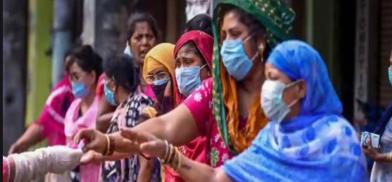Extending closure of red light areas can avert peak, reduce deaths
A study conducted by Mumbai's KEM doctors alongside academicians from School of Medicine and Harvard Medical School have found that the extended closure of the red-light areas in India could delay the peak of COVID-19 cases by up to 23 days and the toll could be reduced by 67 percent

New Delhi: A study conducted by Mumbai's KEM doctors alongside academicians from School of Medicine and Harvard Medical School have found that the extended closure of the red-light areas in India could delay the peak of COVID-19 cases by up to 23 days and the toll could be reduced by 67 percent.
The model projects that while West Bengal's red-light areas will experience over 2,000 deaths of sex workers and red light area (RLA) residents if RLAs reopen, Maharashtra too would be one of the worst affected states.
"Moreover, extension of closure of RLAs after lockdown could delay the peak of COVID-19 cases in India by 8-23 days," the report by Code Red COVID read.
Code Read COVID is a global coalition of doctors and researchers from Harvard Medical School, Yale Medical School, KEM Hospital, and other institution.
The study further revealed that there could be over 400,000 infections and 12,000 deaths among red light area workers and residents in the next one year if they are reopened. "There would also be a 43-67.6 percent reduction in the cumulative number of COVID-19-related deaths nationally," the study said.
The study also suggested that it could take at least 18 more months for a vaccine to be development and distributed throughout India may. "In the capital city of New Delhi, the GB Road Red Light Area could experience 2,774 cases, 386 hospitalizations, and 91 deaths," the study said.
Speaking about the findings of this study, co author of this study, Dr Abhishek Pandey from Yale University said, "It is impossible to practice social distancing during sex. Residents of red-light areas including sex workers, pimps, and brothel managers are at higher risk of infection. By keeping red light areas closed till there is an effective preventive measure, thousands of deaths among residents of red-light areas can be averted."
"In the absence of efficacious treatments or vaccines for COVID-19, there are limited public health interventions that can substantially reduce COVID-19 cases and deaths when re-opening a country as large and diverse as India. Extended closure of RLAs in India may be one of these interventions -- and it is feasible," the study suggested.
It further suggested that across all RLAs in India, at least 39.2 percent of cumulative hospitalizations, 39.9 percent of cumulative ICU admissions, and 42.9 percent of cumulative deaths could be averted by the date of the peak of epidemic if the RLAs remain closed.
Not only this, the closure of these areas in cities like Kolkata, Pune and Nagpur could avert all ICU admissions and at least 94.6 percent of their cumulative hospitalizations and at least 92.9 percent of cumulative deaths by the date of the epidemic peak.
In Pune's Budhwar Peth, 4,795 cumulative cases and 162 deaths can occur. In Mumbai's Red-Light Area of Kamathipura, Grant Road, and Faulkland Road, 3,494 cases can come up and 114 deaths can happen. In Nagpur, Itwari Chowk can face 1,667 cases, 236 hospitalizations, and 56 deaths.
Durbar Mahila Samanwaya Committee (DMSC), an NGO working for the welfare of sex workers, has a membership that includes about 65,000 sex workers spread across 50 red light areas in the state.
Smarajit Jana, a doctor and chief advisor of DMSC, said "It would be of great danger if the sex workers are allowed to operate as soon as the lockdown is lifted. Due to their nature of work and the congested way in which they live, one single case can infect a hundred".
"The Indian government has implemented smart and effective measures to flatten the curve, but it is unlikely for the pandemic to be resolved until there is a vaccine. It is therefore important that red light areas remain closed until a vaccine is developed and widely distributed to protect sex workers and the population at large," said co-author Dr. Sudhakar Nuti, Harvard Medical School commenting on the report.
"Government restrictions on this part of the informal economy have not been outlined in COVID-19 directives, but a sex worker in Mumbai was quoted in a media story stating "There will be no business in Kamathipura for at least next two years. We can only return when there's a COVID-19 vaccine," Dr Nuti added.
The study also recommends that sex workers need opportunities to gain skills that provide employment in lower-risk jobs. "There are many social, economic, and health challenges, alongside the spread of COVID19, that sex workers and their families will face under extended closure," it said.
The study states that the residents of these red-light areas live in confined, communal living spaces and without sex work they have very limited access to food and other vital living supplies. "Many sex workers lack government approved documentation and thus are unable to benefit from the government's financial relief packages," the study said.
The study also recommends that closure of these areas should be matched with commensurate programs that extend payments to sex workers as financial relief, ensure sex workers have access to additional resources via robust financial institutions that visibly offer better alternatives to high-interest lending schemes that entrap them in debt bondage.
"The COVID-19 crisis highlights the oft-neglected plight of sex workers and the global health burden that the RLAs impose in the context of infectious diseases. These global health burdens are also associated with extensive socioeconomic tolls. With regard to averting the public health and socioeconomic burdens, it would be beneficial for RLAs to remain closed until COVID-19 prevention and treatment strategies are developed and distributed," the report concluded (IANS)








Post a Comment